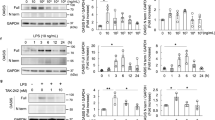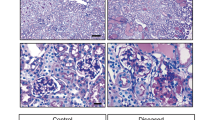Abstract
Background
The induction of CD80 on podocytes has been shown in animal models of podocyte injury and in certain cases of nephrotic syndrome. In a lipopolysaccharide (LPS)-induced mouse model of albuminuria, we have recently shown a signalling axis of LPS-myeloid cell activation-TNFα production-podocyte CD80 induction-albuminuria. Therefore, in this report, we investigated the cellular and molecular consequences of TNFα addition and CD80 expression on cultured podocytes.
Methods
A murine podocyte cell line was used for TNFα treatment and for over-expressing CD80. Expression and localization of various podocyte proteins was analysed by reverse transcriptase-polymerase chain reaction, western blotting and immunofluorescence. HEK293 cells were used to biochemically characterize interactions.
Results
Podocytes treated with LPS in vitro did not cause CD80 upregulation but TNFα treatment was associated with an increase in CD80 levels, actin derangement and poor wound healing. Podocytes stably expressing CD80 showed actin derangement and co-localization with Neph1. CD80 and Neph1 interaction was confirmed by pull down assays of CD80 and Neph1 transfected in HEK293 cells.
Conclusion
Addition of TNFα to podocytes causes CD80 upregulation, actin reorganization and podocyte injury. Overexpressed CD80 and Neph1 interact via their extracellular domain. This interaction implies a mechanism of slit diaphragm disruption and possible use of small molecules that disrupt CD80-Neph1 interaction as a potential for treatment of nephrotic syndrome associated with CD80 upregulation.





Similar content being viewed by others
References
Brinkkoetter PT, Ising C, Benzing T. The role of the podocyte in albumin filtration. Nat Rev Nephrol. 2013;9(6):328–36. doi:10.1038/nrneph.2013.78.
Pavenstadt H, Kriz W, Kretzler M. Cell biology of the glomerular podocyte. Physiol Rev. 2003;83(1):253–307. doi:10.1152/physrev.00020.2002.
Vivarelli M, Massella L, Ruggiero B, Emma F. Minimal change disease. Clin J Am Soc Nephrol. 2017;12(2):332–45. doi:10.2215/CJN.05000516.
Mathieson PW. Immune dysregulation in minimal change nephropathy. Nephrol Dial Transplant. 2003;18(Suppl 6):vi26-9.
Zhang H, Wang Z, Dong L, Guo Y, Wu J, Zhai S. New insight into the pathogenesis of minimal change nephrotic syndrome: role of the persistence of respiratory tract virus in immune disorders. Autoimmun Rev. 2016;15(7):632–7. doi:10.1016/j.autrev.2016.02.007.
Lai KW, Wei CL, Tan LK, Tan PH, Chiang GS, Lee CG, et al. Overexpression of interleukin-13 induces minimal-change-like nephropathy in rats. J Am Soc Nephrol. 2007;18(5):1476–85. doi:10.1681/ASN.2006070710.
Reiser J, von Gersdorff G, Loos M, Oh J, Asanuma K, Giardino L, et al. Induction of B7-1 in podocytes is associated with nephrotic syndrome. J Clin Investig. 2004;113(10):1390–7. doi:10.1172/JCI20402.
Garin EH, Diaz LN, Mu W, Wasserfall C, Araya C, Segal M, et al. Urinary CD80 excretion increases in idiopathic minimal-change disease. J Am Soc Nephrol. 2009;20(2):260–6. doi:10.1681/ASN.2007080836.
Garin EH, Mu W, Arthur JM, Rivard CJ, Araya CE, Shimada M, et al. Urinary CD80 is elevated in minimal change disease but not in focal segmental glomerulosclerosis. Kidney Int. 2010;78(3):296–302. doi:10.1038/ki.2010.143.
Fiorina P, Vergani A, Bassi R, Niewczas MA, Altintas MM, Pezzolesi MG, et al. Role of podocyte B7-1 in diabetic nephropathy. J Am Soc Nephrol. 2014;25(7):1415–29. doi:10.1681/ASN.2013050518.
Yu CC, Fornoni A, Weins A, Hakroush S, Maiguel D, Sageshima J, et al. Abatacept in B7-1-positive proteinuric kidney disease. N Engl J Med. 2013;369(25):2416–23. doi:10.1056/NEJMoa1304572.
Benigni A, Gagliardini E, Remuzzi G. Abatacept in B7-1-positive proteinuric kidney disease. N Engl J Med. 2014;370(13):1261–3. doi:10.1056/NEJMc1400502#SA1.
Salant DJ. Podocyte expression of B7-1/CD80: is it a reliable biomarker for the treatment of proteinuric kidney diseases with abatacept? J Am Soc Nephrol. 2016;27(4):963–5. doi:10.1681/ASN.2015080947.
Larsen CP, Messias NC, Walker PD. B7-1 immunostaining in proteinuric kidney disease. Am J Kidney Dis. 2014;64(6):1001–3. doi:10.1053/j.ajkd.2014.07.023.
Gagliardini E, Novelli R, Corna D, Zoja C, Ruggiero B, Benigni A, et al. B7-1 is not induced in podocytes of human and experimental diabetic nephropathy. J Am Soc Nephrol. 2016;27(4):999–1005. doi:10.1681/ASN.2015030266.
Shimada M, Ishimoto T, Lee PY, Lanaspa MA, Rivard CJ, Roncal-Jimenez CA, et al. Toll-like receptor 3 ligands induce CD80 expression in human podocytes via an NF-kappaB-dependent pathway. Nephrol Dial Transplant. 2012;27(1):81–9. doi:10.1093/ndt/gfr271.
Jain N, Khullar B, Oswal N, Banoth B, Joshi P, Ravindran B, et al. TLR-mediated albuminuria needs TNFalpha-mediated cooperativity between TLRs present in hematopoietic tissues and CD80 present on non-hematopoietic tissues in mice. Dis Model Mech. 2016;9(6):707–17. doi:10.1242/dmm.023440.
Srivastava T, Sharma M, Yew KH, Sharma R, Duncan RS, Saleem MA, et al. LPS and PAN-induced podocyte injury in an in vitro model of minimal change disease: changes in TLR profile. J Cell Commun Signal. 2013;7(1):49–60. doi:10.1007/s12079-012-0184-0.
Gurkan S, Cabinian A, Lopez V, Bhaumik M, Chang JM, Rabson AB, et al. Inhibition of type I interferon signalling prevents TLR ligand-mediated proteinuria. J Pathol. 2013;231(2):248–56.
Ishimoto T, Shimada M, Gabriela G, Kosugi T, Sato W, Lee PY, et al. Toll-like receptor 3 ligand, polyIC, induces proteinuria and glomerular CD80, and increases urinary CD80 in mice. Nephrol Dial Transplant. 2013;28(6):1439–46. doi:10.1093/ndt/gfs543.
Schiwek D, Endlich N, Holzman L, Holthofer H, Kriz W, Endlich K. Stable expression of nephrin and localization to cell-cell contacts in novel murine podocyte cell lines. Kidney Int. 2004;66(1):91–101. doi:10.1111/j.1523-1755.2004.00711.x.
Takano Y, Yamauchi K, Hiramatsu N, Kasai A, Hayakawa K, Yokouchi M, et al. Recovery and maintenance of nephrin expression in cultured podocytes and identification of HGF as a repressor of nephrin. Am J Physiol Ren Physiol. 2007;292(5):F1573–82. doi:10.1152/ajprenal.00423.2006.
Clement LC, Avila-Casado C, Mace C, Soria E, Bakker WW, Kersten S, et al. Podocyte-secreted angiopoietin-like-4 mediates proteinuria in glucocorticoid-sensitive nephrotic syndrome. Nat Med. 2011;17(1):117–22. doi:10.1038/nm.2261.
Zhang SY, Kamal M, Dahan K, Pawlak A, Ory V, Desvaux D, et al. c-mip impairs podocyte proximal signaling and induces heavy proteinuria. Sci Signal. 2010;3(122):ra39. doi:10.1126/scisignal.2000678.
Lennon R, Singh A, Welsh GI, Coward RJ, Satchell S, Ni L, et al. Hemopexin induces nephrin-dependent reorganization of the actin cytoskeleton in podocytes. J Am Soc Nephrol. 2008;19(11):2140–9. doi:10.1681/ASN.2007080940.
Hahm E, Wei C, Fernandez I, Li J, Tardi NJ, Tracy M, et al. Bone marrow-derived immature myeloid cells are a main source of circulating suPAR contributing to proteinuric kidney disease. Nat Med. 2017;23(1):100–6. doi:10.1038/nm.4242.
Baye E, Gallazzini M, Delville M, Legendre C, Terzi F, Canaud G. The costimulatory receptor B7-1 is not induced in injured podocytes. Kidney Int. 2016;90(5):1037–44. doi:10.1016/j.kint.2016.06.022.
Koukouritaki SB, Vardaki EA, Papakonstanti EA, Lianos E, Stournaras C, Emmanouel DS. TNF-alpha induces actin cytoskeleton reorganization in glomerular epithelial cells involving tyrosine phosphorylation of paxillin and focal adhesion kinase. Mol Med. 1999;5(6):382–92.
Arif E, Rathore YS, Kumari B, Ashish F, Wong HN, Holzman LB, et al. Slit diaphragm protein Neph1 and its signaling: a novel therapeutic target for protection of podocytes against glomerular injury. J Biol Chem. 2014;289(14):9502–18. doi:10.1074/jbc.M113.505743.
Arif E, Wagner MC, Johnstone DB, Wong HN, George B, Pruthi PA, et al. Motor protein Myo1c is a podocyte protein that facilitates the transport of slit diaphragm protein Neph1 to the podocyte membrane. Mol Cell Biol. 2011;31(10):2134–50. doi:10.1128/MCB.05051-11.
Kim EY, Chiu YH, Dryer SE. Neph1 regulates steady-state surface expression of Slo1 Ca(2+)-activated K(+) channels: different effects in embryonic neurons and podocytes. Am J Physiol Cell Physiol. 2009;297(6):C1379–88. doi:10.1152/ajpcell.00354.2009.
Grahammer F, Schell C, Huber TB. The podocyte slit diaphragm—from a thin grey line to a complex signalling hub. Nat Rev Nephrol. 2013;9(10):587–98. doi:10.1038/nrneph.2013.169.
Peach RJ, Bajorath J, Naemura J, Leytze G, Greene J, Aruffo A, et al. Both extracellular immunoglobin-like domains of CD80 contain residues critical for binding T cell surface receptors CTLA-4 and CD28. J Biol Chem. 1995;270(36):21181–7.
Donoviel DB, Freed DD, Vogel H, Potter DG, Hawkins E, Barrish JP, et al. Proteinuria and perinatal lethality in mice lacking NEPH1, a novel protein with homology to NEPHRIN. Mol Cell Biol. 2001;21(14):4829–36. doi:10.1128/MCB.21.14.4829-4836.2001.
Wagner MC, Rhodes G, Wang E, Pruthi V, Arif E, Saleem MA, et al. Ischemic injury to kidney induces glomerular podocyte effacement and dissociation of slit diaphragm proteins Neph1 and ZO-1. J Biol Chem. 2008;283(51):35579–89. doi:10.1074/jbc.M805507200.
Doublier S, Ruotsalainen V, Salvidio G, Lupia E, Biancone L, Conaldi PG, et al. Nephrin redistribution on podocytes is a potential mechanism for proteinuria in patients with primary acquired nephrotic syndrome. Am J Pathol. 2001;158(5):1723–31. doi:10.1016/S0002-9440(10)64128-4.
Author information
Authors and Affiliations
Contributions
BK, RB, NO, NJ, AS and SS carried out the experiments. SS, SR and VB conceived the notion and provided intellectual content. BK compiled and analyzed the data and helped in manuscript preparation. MZA provided help in data analysis. AB, SB, UCMN and NW helped in data analysis and interpretation. SS, VB, SR and AG interpreted the data and wrote the article.
Corresponding author
Ethics declarations
Sources of funding
This work was supported in part by grants from the Department of Biotechnology, Ministry of Science and Technology (DBT) India (Grant numbers BT/PR12849/MED/15/35/2009 and BT/PR5138/BRB/10/1064/2012 to AG, Grant numbers BT/PR-14592/BRB/10/858/2010 and BT/PR/14651/MED/30/566/2010 to SR, Grant number BT/PR14420/Med/29/213/2010 to VB, and Grant number BT/Bio CARe/08/48/2010-2011 to SS); Department of Science and Technology, Ministry of Science and Technology, India (Grant number SR/SO/BB-0035/2013 to AG, grant number SR/SO/HS-0005/2011 to VB) and fellowships from the Council of Scientific and Industrial Research to BK, NO and NJ. National Institute of Immunology and Translational Health Science and Technology Institute are supported by DBT, Government of India.
Conflict of interest
The authors declare no competing or financial interests.
Research involving animals
All mice handling was done at the National Institute of Immunology (NII) and mice were used with the approval of the NII Institutional Animal Ethics Committee (IAEC). The title of the IAEC approved project was “Studies to understand pathogenic mechanisms associated with proteinuria in nephrotic syndrome” with approval number NII-IAEC#349/14.
Informed consent
No human subjects were involved in this study.
About this article
Cite this article
Khullar, B., Balyan, R., Oswal, N. et al. Interaction of CD80 with Neph1: a potential mechanism of podocyte injury. Clin Exp Nephrol 22, 508–516 (2018). https://doi.org/10.1007/s10157-017-1489-3
Received:
Accepted:
Published:
Issue Date:
DOI: https://doi.org/10.1007/s10157-017-1489-3




